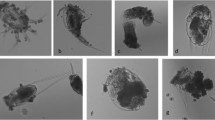Abstract
The impact of predation by juvenile marbled gobies,Pomatoschistus marmoratus, on the meiobenthic harpacticoid copepodCanuella perplexa was investigated at a subtidal station located in a shallow-water, brackish embayment of the Po River delta, northern Italy, in summer and fall 1978. In august, predation mainly centered on adults, with a very large number of prey for each predator; the energy supplied by the harpacticoid is high enough to sustain, almost entirely, the gobies’ daily energy requirement. The situation is different in September and October, when the adult copepod population declines dramatically and predation is shifted to less energy-providing copepodites and marbled gobies sensibly widen their prey spectrum.C. perplexa showed alterations of biological parameters, such as clutch size and average brood size, to cope with such a heavy predation pressure.
Similar content being viewed by others
Literature Cited
Alheit, J. andW. Scheibel. 1982. Benthic harpacticoids as a food source for fish.Marine Biology 70:141–147.
Andersen, N. G.. 1984. Depletion rates of gastrointestinal content in common goby (Pomatoschistus microps (Kr.)). Effects of temperature and fish size.Dana 3:31–42.
Bodiou, J. Y. andL. Villiers. 1978–79. La predation de la meiofaune par les formes juveniles deDeltentosteus quadrimaculatus (Teleostei, Gobiidae).Vie et Milieu Series AB 28–29:143–156.
Ceccherelli, V. U., D. Cortesi, andG. Fabbri. 1982. Dinamica stagionale di una taxocenosi ad Arpacticoidi di ambiente salmastro.Bollettino dei Musei e degli Istituti Biologici dell’Università di Genova 50:151–155.
Ceccherelli, V. U. andM. Mistri. 1991. Production of the meiobenthic harpacticoid copepodCanuella perplexa.Marine Ecology Progress Series 68:225–234.
Coull, B. C. 1990. Are members of the meiofauna food for higher trophic levels?Transactions of the American Microscopical Society 109:233–246.
Coull, B. C. andJ. B. J. Wells. 1983. Refuges from fish predation: Experiments with phytal meiofauna from the New Zealand rocky intertidal.Ecology 64:1599–1609.
Edmondson, W. T. 1960. Reproductive rates of rotifers in natural populations.Memorie dell’Istituto Italiano di Idrobiologia 12: 21–77.
Ellis, M. J. andB. C. Coull. 1989. Fish predation on meiobenthos: Field experiments with juvenile spotLeiostomus xanthurus Lacepède.Journal of Experimental Marine Biology and Ecology 130:19–32.
Feller, R. J., B. C. Coull, andB. T. Hentschel. 1990. Meiobenthic copepods: Tracers of where juvenileLeiostomus xanthurus (Pisces) feed?Canadian Journal of Fisheries and Aquatic Sciences 47:1913–1919.
Gee, J. M. 1987. Impact of epibenthic predation on estuarine intertidal harpacticoid copepod populations.Marine Biology 96:497–510.
Gee, J. M. 1989. An ecological and economic review of meiofauna as food for fish.Zoological Journal of the Linnean Society 96:243–261.
Hamerlynck, O., C. Heip, and F. Redant. 1986. Life history, food consumption, and resource partitioning in two sympatric gobies,Pomatoschistus minutus andP. lozanoi, in the Belgian coastal waters.International Council for the Exploration of the Sea C. M. 1986/L:14.
Hicks, G. R. F. 1984. Spatio-temporal dynamics of a meiobenthic copepod and the impact of predation-disturbance.Journal of Experimental Marine Biology and Ecology 81:47–72.
Hoppenheit, M. 1976. Zur Dinamik exploitierter Populationen vonTisbe holothuriae (Copepoda, Harpacticoida). III. Reproduktion, Geschlechtsverhaeltnis, Entwicklungsdauer und Ueberlebenszeit.Helgolaender wissenschaftlicher Meeresuntersuchen 28:109–137.
Jobling, M. 1980a. Gastric evacuation in plaice,Pleuronectes platessa L.: Effects of dietary energy level and food composition.Journal of Fish Biology 17:187–196.
Jobling, M. 1980b. Gastric evacuation in plaice,Pleuronectes platessa L.: Effects of temperature and fish size.Journal of Fish Biology 17:547–551.
Jobling, M. andP. Spencer Davies. 1979. Gastric evacuation in plaice,Pleuronectes platessa L.: Effects of temperature and meal size.Journal of Fish Biology 14:539–546.
Kayser, C. andA. Heusner. 1964. Etude comparative du metabolisme energetique dans la serie animale.Journal de Physiologie (Paris) 56:489–524.
Maccagnani, R., A. Carrieri, P. Franzoi, andR. Rossi. 1985. Osservazioni sulla struttura di popolazione ed il ruolo trofico di tre species di gobidi (Knipowitschia panizzae, Pomatoschistus marmoratus, Pomatoschistus canestrinii) in un ambiente del Delta del Po.Nova Thalassia 7:373–378.
McCall, J. N. 1992. Source of harpacticoid copepods in the diet of juvenile starry flounder.Marine Ecology Progress Series 86:41–50.
Mistri, M. andV. U. Ceccherelli. 1992. Field population dynamics of six harpacticoids species in a lagoon of the Po River Delta, p. 293–298.In G. Colombo (ed.), Marine Eutrophication and Population Dynamics. Olsen and Olsen, Fredensborg, Denmark.
Morris, J. T. andB. C. Coull. 1992. Population dynamics, numerical production, and potential predation impact on a meiobenthic capepod.Canadian Journal of Fisheries and Aquatic Sciences 49:609–616.
Nelson, A. L. andB. C. Coull. 1989. Selection of meiobenthic prey by juvenile spot (Pisces): An experimental study.Marine Ecology Progress Series 53:51–57.
Peters, R. H. 1983. The Ecological Implications of Body Size. Cambridge University Press, Cambridge. 329 p.
Robinson, W. R., R. H. Peters, andJ. Zimmerman. 1983. The effect of body size and temperature on metabolic rate of organisms.Canadian Journal of Zoology 61:281–288.
Ryer, C. H. andG. W. Boehlert. 1983. Feeding chronology, daily ration, and the effects of temperature upon gastric evacuation in the pipefishSynagnathus fuscus.Environmental Biology of Fishes 9:301–306.
Smith, L. D. andB. C. Coull. 1987. Juvenile spot (Pisces) and grass shrimp predation on meiobenthos in muddy and sandy substrata.Journal of Experimental Marine Biology and Ecology 105:123–136.
Tito de Morais, L. andJ. Y. Bodiou. 1984. Predation on meiofauna by juvenile fish in a western Mediterranean flatfish nursery ground.Marine Biology 82:209–215.
Author information
Authors and Affiliations
Rights and permissions
About this article
Cite this article
Ceccherelli, V.U., Mistri, M. & Franzoi, P. Predation impact on the meiobenthic harpacticoidCanuella perplexa in a lagoon of the Po River Delta, Italy. Estuaries 17, 283–287 (1994). https://doi.org/10.2307/1352577
Received:
Accepted:
Issue Date:
DOI: https://doi.org/10.2307/1352577




